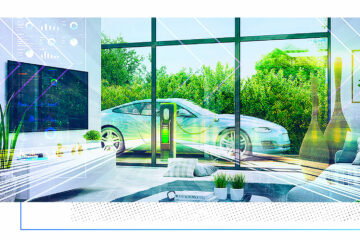Hear more from Jason McGrade about SECC’s research findings in the on-demand video of his Customer Perspectives on EVs, Smart Homes, and Beneficial Electrification session and then explore how Analytics Workbench can help you implement more effective customer-centered carbon reduction programs and strategies.
The Smart Energy Consumer Collaborative (SECC) serves as a trusted industry resource, shining a light on the voice of energy consumers across major themes, including grid modernization, power delivery and usage, and energy literacy. SECC Deputy Director Jason McGrade discussed some of the organization’s latest findings with me as part of an Engage 2021 session entitled, “Customer Perspectives on EVs, Smart Homes, and Beneficial Electrification.” In particular, he shared five key insights that utilities should consider as they make plans to advance their carbon reduction goals.
1. The Message
Utilities are currently promoting beneficial electrification and carbon reduction goals using a broad range of language with varying degrees of success. SECC’s research found that one message is resonating more with consumers than any other: electricity is becoming cleaner and more renewable every day.
“This statement conveys the urgency of the climate change issues, the current grid access and resiliency and reliability — all the different factors that go into the positive incentives for beneficial electrification,” explained McGrade. “Consumers get that, and it’s a unifying message that you can really build your strategies around, because it does provide that maximum benefit not only for beneficial electrification, but also in terms of presenting the utility in a more positive light.”
Bidgely’s Analytics Workbench allows utilities to further personalize this message for customers by providing a holistic 360 view of each customer that can be used to segment and target the right customers and provide the right insights to inspire action. When it comes to carbon-saving actions, every customer is inspired by a different set of priorities in the context of his or her own energy usage needs and habits. Using AI-powered AMI data insights, Analytics Workbench identifies these priorities and enables utilities to craft hyper-personalized communications that present electrification and efficiency actions by highlighting the benchmark that best motivates that individual customer.
2. The Role of Rebates
SECC’s research also reveals that the most engaged customer segments may be willing to pay more for programs that have an environmental upside because they value the ability to make a cleaner, more renewable statement. For those who are more price sensitive, having a rebate does provide essential motivation. But surprisingly, that rebate doesn’t need to be very high.
“Just the sheer fact that a rebate exists really does seem to move the needle when it comes to getting consumers to engage with these types of programs. You don’t need an extremely large rebate to move consumers into this space,” said McGrade.
With that reality in mind, McGrade agreed that lowering the rebate while expanding rebate programs to offer them to as many consumers as possible could effectively drive more beneficial electrification for utilities.
Bidgely’s Analytics Workbench helps utilities improve both the reach and the return on their rebate programs in two ways: by replacing mass marketing with communications targeted only to those customers who qualify for a particular rebate; and by leveraging Bidgely’s digital-first customer communications platform for rebate program promotion. Both enable utilities to save significant marketing dollars that can be redeployed to grow rebate programs.
3. Novelty vs. Value
SECC has found that current smart home technology owners see their devices as both fun and easy to use as well as a means to realize energy savings and improved home comfort. Non-owners haven’t yet made the same connection, and view smart home technology as a novelty rather than something that provides them with actual value.
“From a utility standpoint, the key is to help non-owners understand that smart home technology can help provide improved home comfort and energy efficiency in an easy-to-use manner,” emphasized McGrade. “For existing smart home technology owners, the challenge is to make sure that those consumers are motivated to take next step actions to get the maximum benefit from their technology. For example, a customer might have a smart thermostat installed, but hasn’t taken the next step to program it to optimize energy usage in alignment with household routines, and therefore isn’t realizing the benefit of the technology.”
Bidgely’s Smart Alerts help utilities engage with customers ‘where they are’ when it comes to smart device ownership through utility-branded emails, SMS and mobile app messages that deliver energy smart device recommendations based on each customer’s unique consumption patterns and preferences. Sending personalized and highly relevant communications through a variety of digital channels cost-effectively ensures no customer is left behind. Smart Alerts not only engage consumers broadly, but also take it one step further to more effectively motivate them to take meaningful actions.
SECC’s research has also shown that renters are as interested in taking advantage of smart home technologies as are homeowners. That said, they have some hesitancy that is tied mainly to concerns that requests to have new devices installed could cause an increase in rent or elicit a negative reaction from a landlord.
“There is certainly an opportunity for utilities to take an active role in communicating these benefits across all parties,” said McGrade. “This is again where potential incentives might come into play to offset the cost for the upfront installation or the technology purchase. That’s where the utility can really help play a role to incentivize adoption.”
Investing in increasing smart home technology device ownership across a utility customer base can pay big dividends when it comes to energy savings and decarbonization goals.
“Among smart home device owners, we saw 21% of consumers change their usage as a result of a particular smart device,” emphasized McGrade. “Having access to their energy use data helped motivate change. So that’s a big win. If you can motivate change within 20% of your customer base, that’s a serious opportunity utilities should be taking advantage of.”
4. Build it and They Will Buy
SECC’s research reveals that the most significant barrier to electric vehicle adoption continues to be driver concern about finding sufficient charging stations where they commonly travel.
“Access to charging stations remains the number one barrier to purchase,” McGrade said. “In particular, making sure that there’s a public charging option in range really does help motivate renters and other customers who don’t have a home charging option to purchase an EV, because there is a great deal of continued interest from these customer segments.”
5. Act as a Trusted Advisor
McGrade suggested that utilities regard EV purchases as another major capital investment decision they can and should influence — similar to air conditioning units.
“I see EVs in a similar vein, where you have a new capital investment that the consumer is potentially able to make, and utilities should do what they can to help partner and work with their customers to ensure they remain that trusted energy provider. I really think it’s an opportunity for utilities to work with consumers in this space to improve and build on that trust by demonstrating where and how you are working to the customers’ benefit, rather than ‘here’s a bill at the end of the month,’” he said.
EV ownership patterns are complex and only becoming more so. They are mobile, they consume electricity at varying patterns and varying rates, and eventually, they may supply energy back to the grid. Therefore, the sooner a utility can start to engage and work with a customer in a collaborative fashion as a trusted EV advisor, the easier it will be to manage EV load in the future.
Bidgely provides the broadest and deepest solution in the industry to engage and manage EV ownership. Starting with better targeting customer education and purchasing promotions through buying propensity and other customer insights, to new driver relationship-building tools, to load balancing via peak use detection, load shifting and managed charging programs, Bidgely’s EV Solution allows utilities to advise and influence EV customers at every point on their EV journey.
Takeaway-Driven Next Steps Hear more from Jason McGrade about SECC’s research findings in the on-demand video of his Customer Perspectives on EVs, Smart Homes, and Beneficial Electrification session and then explore how Analytics Workbench can help you implement more effective customer-centered carbon reduction programs and strategies.


